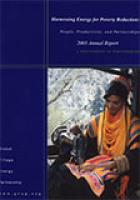Publications

Twenty million people (about half of Central America´s population) cook primarily with biomass using open fires or rudimentary stoves. Approximately 86 percent of the biomass users are concentrated in Guatemala, Honduras, and Nicaragua, including both urban and rural areas. However, less than 10 percent of the biomass users use improved cooking devices. Burning biomass in inefficient cookstoves is associated with adverse impacts on health, primarily among women and children, and with environment and climate change impacts.
In Central America 37,000 premature deaths per year are estimated to be associated with household air pollution from smoke due to wood burning. Household air pollution is linked to pneumonia in children, and low birth weight, impaired cognitive ability, and chronic lung disease in women. It is one of the top 5 risk factors contributing to mortality and morbidity in three of the Central American countries (Guatemala, Honduras and Nicaragua).
This study finds that the use of biomass for cooking in the region will likely continue to be significant for a long time due to population growth, high incidence of poverty, high prices for household gas (LPG) coupled with unsustainable LPG subsidies, as well as relatively easy access to fuelwood in the region.
Useful lessons can be learned from the last decade of experience in Central America and other regions in promoting improved stoves. Providing households with clean and efficient cooking solutions is not just an energy issue, but touches on poverty, gender inequality, public health, environmental sustainability, climate change, agriculture, and local employment. A large-scale, regional clean cooking program requires a solid technical component and an enabling environment that oversees and coordinates energy, health, environment, and gender issues related to household biomass use.
To work towards the goal of universal access to clean cooking solutions, the report makes a number of key recommendations, including:
-
Develop regional standards for improved cookstoves and remove regional trade barriers.
-
Develop country-based information campaigns so that end-users understand how improved cookstoves can help save fuel, provide a healthy environment for women and children, and ensure environmental sustainability.
-
Provide tailored financial assistance for both cookstove manufacturers and users.
-
Develop advanced products that not only have proven technical performance, but also cater to user preferences and social cultural demands.
Following the publication of this report, the World Bank is developing a regional clean cooking program in partnership with the regional organization SICA (Sistema de la Integracion Centroamericana) and country governments.